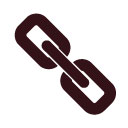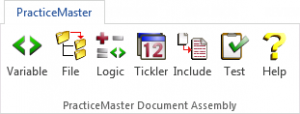
Spotlight: PracticeMaster
June 2024 Tags: AOPs, Calendar, Conflict of Interest, Contacts, Document Assembly, Document Management, Filters, PracticeMaster, QuickViews, Report Writer, WorkFlows
No comments
In a law firm, there can be an overwhelming amount of information to keep track of and work with – case information, contact information, upcoming meetings, research, emails, and documents galore. PracticeMaster can help make you more organized than you’ve ever been before. PracticeMaster provides the tools you need to manage it all.
Calendar – View not just your calendar, but all appointments for everyone in your office. View appointments for a specific client or matter, an employee, or view appointments based on any information in the calendar record such as date, calendar code, and location.
Contacts – Don’t just search your list of contacts; see all the contacts for any matter at a glance, and every matter in which a particular contact is involved.
Document Management – Tell PracticeMaster how you want to name and sort your documents, and then let PracticeMaster do it for you! Quickly see all documents for a case, or different versions of the same kind of documents across all your cases.
Matter Manager – Tie everything for a matter together in one place: calendar records, contacts, email, meeting notes, documents, billing summary, and more!
Conflict of Interest – Determine any potential conflicts by searching files, documents, email attachments, and contacts for key words. Optionally limit results to certain files, and more.
Timers – Use timers to track your time, phone tasks, and research. Switch between timers as needed, and then process timer records into fees!
Filtering – Add filters to your files so that you can easily see only those records that you want to see.
QuickViews – QuickViews combine a filter, column layout, and sort option into a tab at the top of the List tab of any file, which allows you to quickly switch your view depending on the records you are working with. Add Smart tabs to provide an additional level of record sorting.
Integration – Integrate calendar records and contacts with Outlook. Install the PracticeMaster toolbar in Microsoft Outlook, Word, Excel, and PowerPoint; Adobe Reader or Acrobat; Corel WordPerfect; and Ricoh ScanSnap to save documents and research to PracticeMaster, or to create journal entries, calendar entries, or fees from within the other software. Integrate with Tabs3 CRM, LexShare, NetDocuments, and CalendarRules.
Areas of Practice – Areas of Practice provide a way to save separate information for different types of matters, without having the clutter of everything all in one file or set of files.
Report Writer – Create custom reports using the data stored in PracticeMaster.
WorkFlows – Help automate your workload by creating WorkFlows to automatically start tasks or notify other users based on specified events.
Document Assembly – Help automate form letters by creating document templates that pull information from any file in PracticeMaster. Once created, simply select the client and the template, and it does the rest.
For more information about PracticeMaster features or to purchase a license of PracticeMaster, contact your local consultant, or contact our Sales Department at (402) 419-2200.

KB Corner: All About Expressions
November 2023 Tags: Document Assembly, Filters, ODBC, Outlook Integration, Report Writer, Resources, WorkFlows
No comments
What are expressions, and how can your firm use them to improve your day-to-day activities? An expression is a set of criteria you define that tells the software what records to display, and in some cases, how to display it. Filters are the most common expressions, but expressions can also be used in Report Writer reports, WorkFlows, Word Document Assembly, and Outlook Synchronization.
- Filter expressions help narrow down the records that are displayed in Tabs3 Billing lists and PracticeMaster files, and can be used in QuickViews.
- Expressions in Report Writer reports can filter the records to be included as well as format how data is shown on the report.
- Expressions can be used in WorkFlows to filter the records affected by the WorkFlow, as well as to format text in records, email messages, and more.
- Expressions in Word Document Assembly can be used to filter records, as well as to format text that appears in the assembled document.
- Expressions in Outlook Synchronization can be used to filter the contact records that are synchronized with Outlook.
So how can you learn more about expressions? Knowledge Base Article R11493, “All About Expressions,” provides the basics on expressions by breaking information down to explain what expressions are, where they’re used, and common terminology associated with them. This article also shows you how to create both simple and advanced expressions, provides filter examples, and has tips for making the most of filter expressions. To go one step further, for a list of more than 60 filter expression examples, including the file and scenario in which it would be used, visit Knowledge Base Article R11515, “Filter Expression Examples.” Take a little time to check out these resources so you can put this powerful feature to work for you and your firm!
Our Knowledge Base can be accessed at support.Tabs3.com. You can also access our Knowledge Base in the Quick Launch by searching for and selecting “Knowledge Base.”

KB Corner: Working with PracticeMaster Document Assembly
May 2023 Tags: Document Assembly, Microsoft Office Integration, PracticeMaster, Resources
No comments
Are you creating forms and letters manually? If so, you’re probably spending too much time on it. Take advantage of PracticeMaster’s document assembly feature instead! Not quite sure where to begin? First, take a look at how many documents your firm assembles and which documents would save you the most time by automating them. Start with those frequently used documents.
Then, take a look at Knowledge Base Article R11447, “Working with PracticeMaster Document Assembly.” This article provides information on how to create a document template, how to assemble a document, FAQs, and more!
Our Knowledge Base can be accessed at support.Tabs3.com. You can also access our Knowledge Base in the Quick Launch by searching for and selecting “Knowledge Base.”

Video of the Month: Intro to Coding Document Assembly Templates
June 2022 Tags: Document Assembly, Document Management, PracticeMaster, Resources
No comments
If your firm creates the same documents for clients on a monthly, weekly, or even daily basis, it can be a struggle to constantly rewrite and maintain your documents effectively. By using variables to automatically pull information into your commonly used documents, you can save time without the hassle of duplicate entry.
The Intro to Coding Document Assembly Templates video walks you through the basics of creating new templates and coding documents to your specifications. Learn how to insert variables, create logic statements, and automate functions like creating a fee based on the completion of a document.
Watch this five-minute video here:
Training Videos can be accessed at Tabs3.com/videos. You can also access the videos in the Quick Launch by searching for and selecting “Training Videos.”

Video of the Month: Intro to Word Document Assembly
October 2020 Tags: Document Assembly, Document Management, Microsoft Office Integration, PracticeMaster, Resources
No comments
When it comes to creating documents for your clients, manually entering all of the necessary information can be tedious. That’s where PracticeMaster’s Word Document Assembly feature can help!
PracticeMaster allows you to quickly and easily assemble individualized documents in Microsoft Word using templates to fit your firm’s needs.
Watch this two-minute video here:
Training Videos can be accessed at Tabs3.com/videos. You can also access the videos while in the software by selecting Help | Training Videos.

Working with WorkFlows: Adding Fees When Assembling Documents
February 2019 Tags: Document Assembly, Document Management, Email, Fees, PracticeMaster, WorkFlows
No comments
I use Word Document Assembly to assemble forms for my business clients. After I save the forms to PracticeMaster as documents, I always create a fee for certain hours and amount values based on the template I’m assembling (defined by Document Type) and write an email to the client. Is there a way for PracticeMaster to automate some of this for me?
This can be accomplished by creating a WorkFlow that prompts the user if they’d like it to run when a Document Management record is created with a particular Document Type (e.g., “Form” or “Proposal”). Fee and email values will be entered automatically.
Once the WorkFlow completes, the document can easily be attached to the email.
To automatically create a fee and start an email every time Document Management records are added with certain Document Types
- From the Maintenance menu, select WorkFlows.
- Under Common Client Related Files, select Document Management, and then click the New button.
- Enter a Name for the WorkFlow (e.g., “Create Fee and Email”).
- In the Source section:
- Select the Filtered Records option and click the Filter button.
- Click the New Row button and select the Document Type field (Doc_Type).
- Select a Test Condition of “equal to”.
- In the Test Value field, select the desired Document Type (e.g., Form).
- Click the Save button.
- In the Event section, select Record Added.
- In the Actions section, click the New button.
- Select Create New Record and click Next.
- Under Common Client Related Files, select Fee and click OK.
- Click the Define Template button.
- Click the set button next to the Client ID field.
- In the Template Expression Editor window, click the Field button, select “Client_ID”, and then click Insert.
- Click OK.
- Click the set button next to the Hours Worked field.
- In the Template Expression Editor window, click the Value button, enter the desired number of hours worked (e.g., “0.50”), and then click OK.
- Click OK.
- Click the (Save) button.
- Click the set button next to the Client ID field.
- Click Finish.
- In the Actions section, click the New button.
- Select Start Email and click Next.
- Click in the To field.
- In the WorkFlow Expression Editor window, click the Field button, select “Client_ID”, and then click Insert.
- At the end of the expression, enter “:Email_Address”, and then click OK.
- Click in the Subject field.
- In the WorkFlow Expression Editor window, click the Value button, enter the applicable text for the subject (e.g., “A document has been created.”), and then click OK.
- Click OK.
- Click in the Body field.
- In the WorkFlow Expression Editor window, click the Value button, enter the applicable text (e.g., “The requested document has been created and attached.”), and then click OK.
- Click OK.
- Clear the Include event information checkbox.
- Click Finish.
- Click Save.
When run, this WorkFlow will start an email to which the document can be attached. To attach the document to the email, select the PracticeMaster tab of the email, click Attach PM Document, and then select the new Document Management record from the list.
Note: This WorkFlow can be created for each Document Type, as needed.
For more information on WorkFlows, refer to our PracticeMaster WorkFlows Guide at Tabs3.com/support/docs.html or Knowledge Base Article R11307, “All About WorkFlows.”

Working with WorkFlows: Prompt to Run Word Document Assembly
February 2018 Tags: Document Assembly, Document Management, PracticeMaster, WorkFlows
No comments
We use Word Document Assembly and often have to send several subpoenas at a time. Is there a way that PracticeMaster can prompt us to keep running Word Document Assembly until we are done?
You can create a WorkFlow so that each time you add a record to Document Management with a Document Type of subpoena (e.g., SUB), you will be prompted to run Word Document Assembly. This allows you to keep taking advantage of Word Document Assembly automatically running, but provides the option to click No to the prompt once you are done.
To create a WorkFlow that prompts you to run Word Document Assembly
- From the Maintenance menu, select WorkFlows.
- Expand the Common Client Related section, select Document Management, and then click the New button.
- Enter a Name for the WorkFlow (e.g., “Create Another SUB”).
- In the Source section:
- Select Filtered Records and then click the Filter button.
- Click the New Row button.
- In the Name column, select Doc_Type.
- Click the Select button.
- In the Test Value column, click the drop-down arrow and select the document type you use for subpoenas (e.g., SUB).
- Click Save.
- In the Events section, select Record Added.
- In the Actions section:
- Click the New button.
- Select Start Document Assembly and then click Next.
- In the Document Template field, click the
 (Open Folder) button.
(Open Folder) button. - Select the Word Document Assembly template you use for subpoenas (e.g., “Witness Subpoena”).
- Click Finish.
- Click Save, and then close the WorkFlows window.
For more information on WorkFlows, refer to our new PracticeMaster WorkFlows Guide at Tabs3.com/support/docs.html or Knowledge Base Article R11307, “All About WorkFlows.”

Feature Article: Word Document Assembly
August 2015 Tags: Document Assembly, PracticeMaster
No comments
Creating form letters, documents, and contracts for clients can be time consuming, and using mail merge is limited by field availability in Word or Outlook. PracticeMaster’s Word Document Assembly is the solution! Word Document Assembly lets you instantly assemble documents that you frequently use.
The Word Document Assembly Toolbar Plug-in can be installed (Maintenance | Integration | Toolbar Plug-ins | Word tab) and used to set up templates for assembling documents. Templates can include placeholders (variables) for specific types of information, such as client name, client address, judge, etc. You can even have the document assembly process prompt you to provide information that you may not have in the client’s file, such as the date that a document was signed.
for assembling documents. Templates can include placeholders (variables) for specific types of information, such as client name, client address, judge, etc. You can even have the document assembly process prompt you to provide information that you may not have in the client’s file, such as the date that a document was signed.
Use ticklers in a template to automatically create a billing entry for the time you spend on a document, or to schedule other tasks. For example, ticklers can automatically schedule a follow-up task for you x number of days after you create the document to follow up with opposing counsel regarding the letter you are sending them.
Once a template has been created, you can assemble a document. Assembling a document will insert the relevant client and case information in your template to produce a new document. Assembling documents from templates is quick and easy. Just click the Word Document Assembly icon on your Documents Task Folder, select the client, and click OK. Once assembly is complete, the document can be saved and printed. PracticeMaster can even create a Document Management record automatically that is linked to the appropriate client, allowing you to easily find this document in the future.
If you haven’t yet worked with the Document Assembly feature in PracticeMaster and are interested in learning more, we recommend the following to help you get started:
View the following training videos at Tabs3.com/videos:
Word Document Assembly Overview
Word Document Assembly Coding
Review the following Knowledge Base articles:
R11015 – How to Start a New Word Document Template
R11447 – Working with PracticeMaster Document Assembly
Identify your top two or three documents to create document assembly templates.
If you have questions, give your PracticeMaster consultant or our Technical Support staff a call at (402) 419-2210. We will be happy to help you.
Recent Comments
- Tabs3 Software on Feature Article: Tabs3 Cloud
- Betty Pinto on Feature Article: Tabs3 Cloud
- Josephine Banaszek on Quick Tip: Application Toolbar
- Christina Weaver on Quick Tip: Use F5 to Insert Time, Date, and User ID
- James Hunter on Spotlight: Reorder Fees